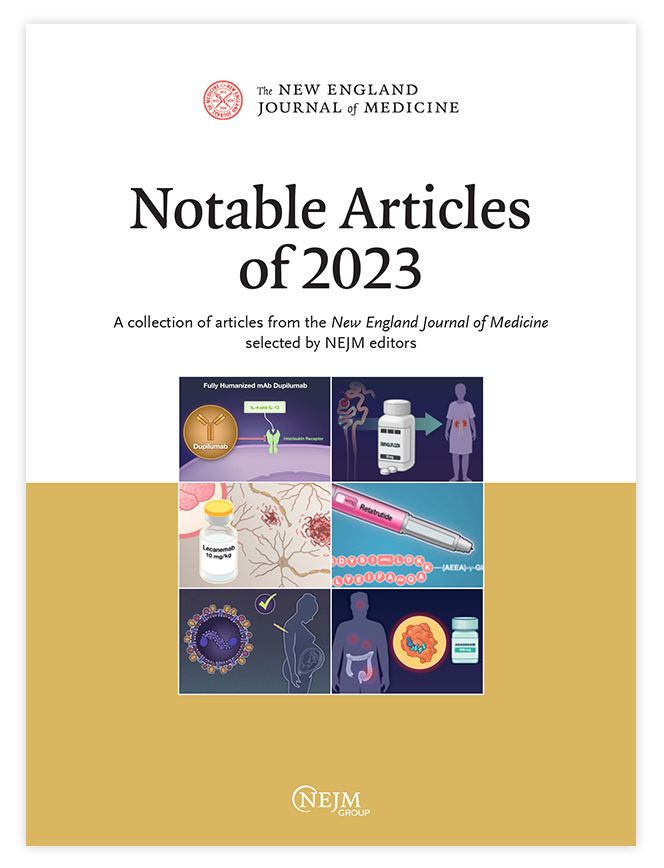多基因风险评分在前列腺癌筛查中的评估。
IF 96.2
1区 医学
Q1 MEDICINE, GENERAL & INTERNAL
引用次数: 0
摘要
背景:前列腺癌的发病率呈上升趋势。用前列腺特异性抗原(PSA)检测筛查有很高的假阳性结果。全基因组关联研究已经确定了前列腺癌患者常见的生殖系变异,可用于计算与前列腺癌风险相关的多基因风险评分。方法:我们从英国的初级保健中心招募55至69岁的患者。利用从唾液中提取的种系DNA,我们从130个已知与前列腺癌风险增加相关的变异中获得了多基因风险评分。多基因风险评分在90百分位或更高的参与者被邀请接受多参数磁共振成像(MRI)和经会阴活检的前列腺癌筛查,无论PSA水平如何。结果入选的40292人中,有8953人(22.2%)表示有兴趣参加,6393人计算了多基因风险评分;745人(11.7%)的多基因风险评分在第90百分位或更高,并被邀请进行筛查。在这745名参与者中,468名(62.8%)接受了MRI和前列腺活检;187名参与者(40.0%)被检测出前列腺癌。诊断时的中位年龄为64岁(范围为57至73岁)。在187名癌症患者中,根据2024年国家综合癌症网络(NCCN)的标准,103名(55.1%)前列腺癌被归类为中等或更高风险,因此需要治疗;根据英国目前使用的前列腺癌诊断途径(高PSA水平和阳性MRI结果),74名(71.8%)参与者未检测出癌症。此外,根据NCCN标准,40名癌症患者(21.4%)的疾病被分类为不利的中等风险或高风险或极高风险。结论:在一个前列腺癌筛查项目中,通过多基因风险评分确定的高危人群中,发现有临床意义疾病的比例高于使用PSA或MRI确定的比例。(由欧洲研究理事会第七框架计划和其他资助;BARCODE1 ClinicalTrials.gov编号:NCT03857477)。本文章由计算机程序翻译,如有差异,请以英文原文为准。
Assessment of a Polygenic Risk Score in Screening for Prostate Cancer.
BACKGROUND
The incidence of prostate cancer is increasing. Screening with an assay of prostate-specific antigen (PSA) has a high rate for false positive results. Genomewide association studies have identified common germline variants in persons with prostate cancer, which can be used to calculate a polygenic risk score associated with risk of prostate cancer.
METHODS
We recruited persons 55 to 69 years of age from primary care centers in the United Kingdom. Using germline DNA extracted from saliva, we derived polygenic risk scores from 130 variants known to be associated with an increased risk of prostate cancer. Participants with a polygenic risk score in the 90th percentile or higher were invited to undergo prostate cancer screening with multiparametric magnetic resonance imaging (MRI) and transperineal biopsy, irrespective of PSA level.
RESULTS
Among 40,292 persons invited to participate, 8953 (22.2%) expressed interest in participating and 6393 had their polygenic risk score calculated; 745 (11.7%) had a polygenic risk score in the 90th percentile or higher and were invited to undergo screening. Of these 745 participants, 468 (62.8%) underwent MRI and prostate biopsy; prostate cancer was detected in 187 participants (40.0%). The median age at diagnosis was 64 years (range, 57 to 73). Of the 187 participants with cancer, 103 (55.1%) had prostate cancer classified as intermediate or higher risk according to the 2024 National Comprehensive Cancer Network (NCCN) criteria, so treatment was indicated; cancer would not have been detected in 74 (71.8%) of these participants according to the prostate cancer diagnostic pathway currently used in the United Kingdom (high PSA level and positive MRI results). In addition, 40 of the participants with cancer (21.4%) had disease classified as unfavorable intermediate risk or as high or very high risk according to NCCN criteria.
CONCLUSIONS
In a prostate cancer screening program involving participants in the top decile of risk as determined by a polygenic risk score, the percentage found to have clinically significant disease was higher than the percentage that would have been identified with the use of PSA or MRI. (Funded by the European Research Council Seventh Framework Program and others; BARCODE1 ClinicalTrials.gov number, NCT03857477.).
求助全文
通过发布文献求助,成功后即可免费获取论文全文。
去求助
来源期刊

New England Journal of Medicine
医学-医学:内科
CiteScore
145.40
自引率
0.60%
发文量
1839
审稿时长
1 months
期刊介绍:
The New England Journal of Medicine (NEJM) stands as the foremost medical journal and website worldwide. With an impressive history spanning over two centuries, NEJM boasts a consistent publication of superb, peer-reviewed research and engaging clinical content. Our primary objective revolves around delivering high-caliber information and findings at the juncture of biomedical science and clinical practice. We strive to present this knowledge in formats that are not only comprehensible but also hold practical value, effectively influencing healthcare practices and ultimately enhancing patient outcomes.
 求助内容:
求助内容: 应助结果提醒方式:
应助结果提醒方式:


